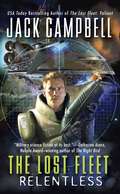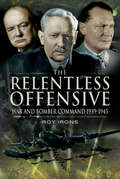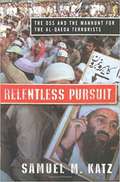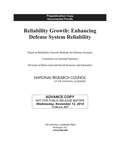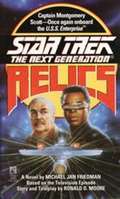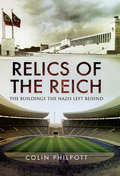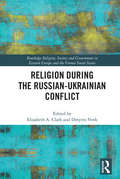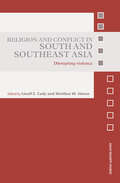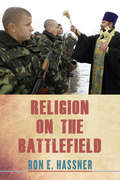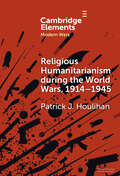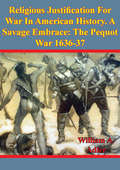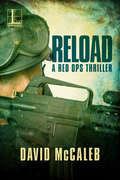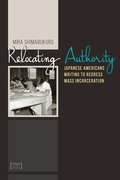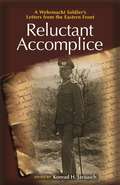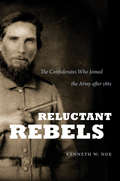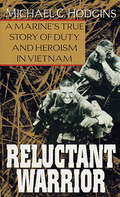- Table View
- List View
Relentless (The Lost Fleet, #5)
by Jack CampbellThawed out after a century of cryogenic sleep, Captain John "Black Jack" Geary has led the Alliance fleet through Syndicate Worlds space, thwarting the enemy at every turn--even within his own ranks--during the long journey home. Alliance prisoners of war are being held at a labor camp in the Heradao Star System, which also happens to be the location of the majority of the surviving Syndic warships. Determined not to leave any of his people behind, Black Jack Geary orders the fleet to strike hard and fast to rescue the POWs with minimal Alliance losses. The raid is successful, but victory is short-lived. Geary discovers that the Syndics plan to ambush the fleet with their powerful reserve flotilla in an attempt to annihilate it once and for all --but he doesn't know where the enemy is located. And as Geary has the fleet jump from one star system to the next, hoping to avoid the inevitable confrontation, saboteurs contribute to the chaos...
Relentless Offensive: War and Bomber Command, 1939–1945
by Roy IronsDuring the years before World War II, the Royal Air Force, created amid the bloodshed of the Great War, saw salvation in the doctrine of a relentless offensive by a bomber force which would sail over trenches and then on to the enemy cities and annihilate the ability of the enemy to wage war. This book gives a view of how that doctrine, driven by courage and coldly sharpened by scientists, brought those visions to reality. This is a fresh analysis of Bomber Command, its tactics and technology. It discusses exactly how well organised Bomber Command was to exploit the rapidly evolving new science and technology of new type of warfare. How much did the concept of Allied and German morale' influenced the Commands operational plans? What was the influence of the Research and Experiments Dept of the Ministry of Home Security and of university scientists such as Tizard and Cherwell? This book delves into the research into high-explosives and firebombing techniques, newly designed bombs and their devastating effect on the enemy. Why in the early war days was the RAF bombers armament so ineffective, the navigation so imprecise and the bombing accuracy so poor? This book also discusses the many varying moral issues that even to this day still rage between those who feel guilt for the destruction of so many German cities and those who see moral justification in the eventual Allied victory.
Relentless Pursuit: The DSS And The Manhunt For The Bin Laden Terrorists
by Samuel M. KatzIt was on February 6, 1993, that the United States was first attacked on its own soil by foreign terrorists. A zealous band of Middle Easterners, holy warriors determined to punish the U.S. for its supposed transgressions against Islam, packed over a ton of home made explosives into the back of a rented van. They drove their bomb across the Hudson from New Jersey, maneuvered it through downtown traffic and parked it in the underground garage at the Vista Hotel, beneath the twin towers of the World Trade Center. They lit a long fuse, which allowed them time to get back to New Jersey to watch the results of the explosion on CNN. They hoped to topple one mammoth tower into the other and kill ten thousand people or more. Miraculously, only six people were killed. <p><p> Most of the group were captured within a week, but the mastermind behind the attack, Ramzi Ahmed Yousef, had immediately gone to JFK airport to fly to Pakistan. Before leaving, he phoned the Associated Press and claimed responsibility for the bombing in the name of the Arab Liberation Army, a terrorist group led by Saudi exile Osama bin Laden. <p> A succession of such brazen crimes has revealed complex connections among terrorist groups with an implacable hostility toward Western civilization. Outrages such as the assassination of the Jewish Defense League founder Meier Kahane, a huge plot in the Philippines to plant bombs on intercontinental airlines and to assassinate the Pope, the bombing of U.S. embassies, culminating in the African embassy bombings of 1998, the attack on the USS Cole in 1999, and the devastating attack on the World Trade Center in 2001 have made it clear that a worldwide network of terrorists led by Osama bin Laden is making war on the United States. <p> On the front lines combating these terrorists in 150 countries around the world have been the 1,200 agents of the U.S. Department of State's Diplomatic Security Service. A little-known but highly effective branch of the government, the DSS is the one arm of federal law enforcement with international powers of arrest. These agents maintain close ties to local police commanders in many countries and can entice informants with bounties of up to $4,000,000. After a challenging international search, it was DSS agents in Pakistan who captured Ramzi Yousef. DSS agents have been in the vanguard of the War on Terrorism long before it was declared. <p> In Relentless Pursuit, Samuel Katz review the escalating series of terrorist attacks on the U.S. during the last decade, including those in many foreign countries and finally in New York and Washington. In the process, he tells the gripping story of the DSS and its agents protecting us and our representatives here and abroad. Katz's detailed, personal, on-the-ground anecdotes bring home the contexts and linkages of the War on Terrorism that has been fought on our behalf by the DSS since the 1980s. Relentless Pursuit is a stirring tribute to an unsung group of brave Americans.
Relentless: A Joe Ledger and Rogue Team International Novel (Rogue Team International Series #2)
by Jonathan MaberryIn New York Times bestselling author Jonathan Maberry's thrilling Relentless, Rogue Team International joins Joe Ledger in a new hunt that spans the globe and journeys deep into the terrifying landscape of the human heart.JOE LEDGER’s world has been torn apart. The people closest to him have been savagely murdered and Ledger is on the hunt for the killers. His already fragile psyche has cracked apart, allowing a dangerous darkness to overwhelm him.His hunt takes him deep into the world of the deadly black market weapons sales, and standing in his way are a new generation of private military contractors. These mercenaries have been enhanced with cutting-edge cybernetics and chemical enhancements, transforming them into real-world super soldiers. Stronger, faster, harder to hurt, and fitted with built-in weapons. They are beyond anything Joe has ever faced.But he is not the Joe Ledger they expected to fight. He is defined by the Darkness now. The attempt to destroy him—to break him—has backfired. Instead his enemies have turned him into a far more fearsome weapon.Everyone is out for blood.
Reliability Growth: Enhancing Defense System Reliability
by Panel on Reliability Growth Methods for Defense SystemsA high percentage of defense systems fail to meet their reliability requirements. This is a serious problem for the U. S. Department of Defense (DOD), as well as the nation. Those systems are not only less likely to successfully carry out their intended missions, but they also could endanger the lives of the operators. Furthermore, reliability failures discovered after deployment can result in costly and strategic delays and the need for expensive redesign, which often limits the tactical situations in which the system can be used. Finally, systems that fail to meet their reliability requirements are much more likely to need additional scheduled and unscheduled maintenance and to need more spare parts and possibly replacement systems, all of which can substantially increase the life-cycle costs of a system. Beginning in 2008, DOD undertook a concerted effort to raise the priority of reliability through greater use of design for reliability techniques, reliability growth testing, and formal reliability growth modeling, by both the contractors and DOD units. To this end, handbooks, guidances, and formal memoranda were revised or newly issued to reduce the frequency of reliability deficiencies for defense systems in operational testing and the effects of those deficiencies. "Reliability Growth" evaluates these recent changes and, more generally, assesses how current DOD principles and practices could be modified to increase the likelihood that defense systems will satisfy their reliability requirements. This report examines changes to the reliability requirements for proposed systems; defines modern design and testing for reliability; discusses the contractor's role in reliability testing; and summarizes the current state of formal reliability growth modeling. The recommendations of "Reliability Growth" will improve the reliability of defense systems and protect the health of the valuable personnel who operate them.
Reliability Issues for DoD Systems: REPORT OF A WORKSHOP
by Committee on National StatisticsA report on Reliability Issues for DoD Systems
Reliability Issues for DoD Systems: REPORT OF A WORKSHOP
by National Research Council of the National AcademiesThe final report of the National Research Council's (NRC) Panel on Statistical Methods for Testing and Evaluating Defense Systems (National Research Council, 1998) was intended to provide broad advice to the U.S. Department of Defense (DoD) on current statistical methods and principles that could be applied to the developmental and operational testing and evaluation of defense systems. To that end, the report contained chapters on the use of testing as a tool of system development; current methods of experimental design; evaluation methods; methods for testing and assessing reliability, availability, and maintainability; software development and testing; and validation of modeling and simulation for use in operational test and evaluation. While the examination of such a wide variety of topics was useful in helping DoD understand the breadth of problems for which statistical methods could be applied and providing direction as to how the methods currently used could be improved, there was, quite naturally, a lack of detail in each area. To address the need for further detail, two DoD agencies-the Office of the Director of Operational Test and Evaluation and the Office of the Under Secretary of Defense for Acquisition, Technology, and Logistics-asked the NRC's Committee on National Statistics to initiate a series of workshops on statistical issues relevant to defense acquisition. The aim of each workshop is to inform DoD about the methods that represent the statistical state of the art and, through interactions of the statistical and defense communities, explore their relevance for DoD application.
Relics
by Michael Jan FriedmanIn the tradition of UNIFICATION, here is the story that fans of the original STAR TREK series and STAR TREK: THE NEXT GENERATION have been clamoring for -- Montgomery Scott's return to the Star Trek universe and his encounter with the crew of the U.S.S. Enterprise NCC 1701-D. Missing in space for seventy-five years, Scotty manages to survive against incredible odds, only to be found by the crew of the Starship Enterprise . Though rescued, Scotty soon finds himself lost in a world that he barely recognizes, a world that has passed him by... But the adventure is not over for Captain Scott who must do the impossible when the new U.S.S. Enterprise faces a very old danger in a remote sector of space. This time, Captain Picard and his crew will need more than all of their courage and all of their skills to save the great Starship from destruction. This time, they will need a miracle worker.
Relics of the Reich: The Buildings the Nazis Left Behind
by Colin PhilpottThe author of Secret Wartime Britain examines the architecture left behind after the Nazis were defeated in World War II. Hitler&’s Reich may have been defeated in 1945, but many buildings, military installations, and other sites remained. At the end of the war, some were obliterated by the victorious Allies, but others survived. For almost fifty years, these were left crumbling and ignored with post-war and divided Germany unsure what to do with them, often fearful that they might become shrines for neo-Nazis. Since the early 1990s, Germans have come to terms with these iconic sites and their uncomfortable part. Some sites are even listed buildings.Relics of the Reich visits many of the buildings and structures built or adapted by the Nazis and looks at what has happened since 1945 to uncover what it tells us about Germany&’s attitude to Nazism now. It also acts as a commemoration of mankind&’s deliverance from a dark decade and serves as renewal of our commitment to ensure history does not repeat itself.
Religion During the Russian Ukrainian Conflict (Routledge Religion, Society and Government in Eastern Europe and the Former Soviet States)
by Elizabeth A. Clark; Dmytro VovkThis book investigates how the military conflict between Russia and Ukraine has affected the religious situation in these countries. It considers threats to and violations of religious freedom, including those arising in annexed Crimea and in the eastern part of Ukraine, where fighting between Ukrainian government forces and separatist paramilitary groups backed and controlled by Russia is still going on, as well as in Russia and Ukraine more generally. It also assesses the impact of the conflict on church-state relations and national religion policy in each country and explores the role religion has played in the military conflict and the ideology surrounding it, focusing especially on the role of the Ukrainian and Russian Orthodox churches, as well as on the consequences for inter-church relations and dialogue.
Religion and Conflict in South and Southeast Asia: Disrupting Violence (Asian Security Studies)
by Linell E. Cady Sheldon W. SimonA major new contribution to comparative and multidisciplinary scholarship on the alignment of religion and violence in the contemporary world, with a special focus on South and Southeast Asia. Religion and Conflict in South and Southeast Asia shows how this region is the site of recent and emerging democracies, a high degree of religious pluralism, the largest Muslim populations in the world, and several well-organized terrorist groups, making understanding of the dynamics of religious conflict and violence particularly urgent. By bringing scholars from religious studies, political science, sociology, anthropology and international relations into conversation with each other, this volume brings much needed attention to the role of religion in fostering violence in the region and addresses strategies for its containment or resolution. The dearth of other literature on the intersection of religion, politics and violence in contemporary South and Southeast Asia makes the timing of this book particularly relevant. This book will of great interest to advanced undergraduate and postgraduate students of Asian politics, security studies and conflict studies.
Religion and Political Violence: Sacred Protest in the Modern World (Contemporary Terrorism Studies)
by Jennifer L. JefferisThis book uses the theory of social movements and first-hand interviews to create a new analysis of religiously motivated political violence in the modern world. Examining the movement to restore Sharia law to a dominant place in the Egyptian government, the movement to make abortion illegal in the United States, and the religious effort to secure territory in Israel, the author contends that religion becomes violent not because of ideology or political context alone, but because of the constantly evolving relationship between them. The ebb and flow of opportunities for political access ensures that secularization and religion, although polar opposites, depend on each other to define themselves. As a result, while their respective degrees of influence will inevitably undulate over time, both will remain a part of the political process for some time. Thus, a full understanding of both is critical to a meaningful understanding of the political process. Much work has been done to understand secular social movements as part of the political process, and consequentially researchers now know a great deal about the motivations, resources and timing of secular social movements. Considerably less research has been done in the field of religious social movements and this book fills that gap in the literature. This book will be of great interest to students of political violence, religion, sociology, and Politics and International Relations in general. Jennifer Jefferis is Assistant Professor in the Department of Government, Regent University, USA, and has a PhD in Political Science from Boston University.
Religion in the Military Worldwide
by Ron E. HassnerHow does religion affect the lives of professional soldiers? How does religion shape militaries, their organization, procedures, and performance? This volume is the first to address these questions by comparing religious symbols and practices in nine countries: Japan, Canada, the United Kingdom, Pakistan, Israel, Iran, India, the United States, and Turkey. The contributors explore how and why soldiers pray, the role of religious rituals prior to battle, the functions that chaplains perform, the effects of religion on recruitment and unit formation, and how militaries grapple with ensuing constitutional dilemmas.
Religion on the Battlefield
by Ron E. HassnerHow does religion shape the modern battlefield? Ron E. Hassner proposes that religion acts as a force multiplier, both enabling and constraining military operations. This is true not only for religiously radicalized fighters but also for professional soldiers. In the last century, religion has influenced modern militaries in the timing of attacks, the selection of targets for assault, the zeal with which units execute their mission, and the ability of individual soldiers to face the challenge of war. Religious ideas have not provided the reasons why conventional militaries fight, but religious practices have influenced their ability to do so effectively.In Religion on the Battlefield, Hassner focuses on the everyday practice of religion in a military context: the prayers, rituals, fasts, and feasts of the religious practitioners who make up the bulk of the adversaries in, bystanders to, and observers of armed conflicts. To show that religious practices have influenced battlefield decision making, Hassner draws most of his examples from major wars involving Western militaries. They include British soldiers in the trenches of World War I, U.S. pilots in World War II, and U.S. Marines in Iraq and Afghanistan. Hassner shows that even modern, rational, and bureaucratized military organizations have taken—and must take—religious practice into account in the conduct of war.
Religious Humanitarianism during the World Wars, 1914–1945: Between Atheism and Messianism (Elements in Modern Wars)
by Patrick J. HoulihanThe history of modern war has focused on destruction; however, practices of saving lives and rebuilding societies have received far less scrutiny. The world wars reconfigured geopolitics on a sacred-secular spectrum dominated by the USA and the USSR. In these events, the motivations of humanitarian actors are disputed as either secular or religious, evoking approval or censure. Although modern global humanitarianism emerged during the world wars, it is often studied in a Euro-centric framework that does not engage the conflicts' globality. The effects of humanitarianism during the Second World War look toward the post-1945 era with not enough reflection on the pre-1945 history of humanitarianism. Thus, what is needed is a critical history beyond moralizing, bringing synchronic and diachronic expansion to study questions of continuity and change. A global history of religious humanitarianism during both world wars places faith-based humanitarianism on a spectrum of belief and unbelief.
Religious Instruction for Soldiers in the First English Civil War, 1642–1646
by Antti TaipaleThis monograph examines religion in the first English Civil War as a tool for war both in instructing soldiers and portraying the enemy. It argues that thus far, the remarkable differences between the teaching of Parliamentarian and Royalist ministers to their respective armies have gone largely unnoticed. Relying on the methodologies of intellectual history combined with a comparative approach, it offers a new interpretation of soldiers&’ religious radicalism and highlights differences between the armies&’ spiritual edification. Hence, it contributes significantly to the history of the Wars of the Three Kingdoms and to the study of political radicalisation leading up to the regicide of Charles I. Moreover, it offers a detailed study of the ways in which religion was used as a tool for war in the early modern period. The role of religion has often been at the centre of historiography of the Wars of the Three Kingdoms (1639-1653). This prominence has culminated in the stereotypical character of a godly Puritan soldier, especially in relation to the New Model Army. However, while there have been debates about the role and importance of religion for the conduct and success of the armies, the theme of soldiers&’ religious instruction as a tool of advice and indoctrination has received less attention. The main aim of this book is thus to rectify this lack in the historiographical mainstream and to set out a new significant interpretation of the religious character of the Civil War.
Religious Justification For War In American History. A Savage Embrace: The Pequot War 1636-37
by William A. AdlerThis thesis examines the ideological justification and conduct of the Pequot War (1636-1637) in Southern New England. It will address as a central issue the role religion played for the English in shaping their response to the challenges of colonization and resistance from indigenous tribes. The first chapter will serve as an introduction to the topic. Chapter's two and three will describe the events prior to and including the conflict in detail. Chapter four will discuss the religious underpinning of Puritan thought and policy. Chapter five will examine the military factors that made the destruction of the Pequot both possible and all but inevitable. Chapter six will conclude the examination and highlight the continued relevance of religion as a shaping force for policy and war.
Religious Radicalism in the Greater Middle East (Cummings Center Series #No. 4)
by Bruce Maddy-Weitzman Efraim InbarThis collection offers a political analysis of religious radicalism in the Greater Middle East - comprising the Middle East, Central Asia and North Africa. The contributors present various conceptual perspectives including international relations, Middle East studies and political sociology.
Reload (The Resurrection Thrillers)
by Karl HillMeet Adam Black: a loner, a fighter, a man bound by honor—and haunted by his past—in this action-packed thriller from the author of The Surgeon. When a long-awaited message sends Adam Black to America, he&’s thrust into a deadly game of betrayal and revenge, uncovering enemies from his time in Afghanistan. Back in Scotland, a seemingly minor act of intervention spirals into a brutal feud with a psychotic heir to a crime empire. From cult compounds to the rugged Scottish hills, Black must rely on his lethal skills to survive. But when the dust settles, can he escape his ghosts—or will they consume him? Black must face his deadliest adversary yet in a brutal showdown that will test his resolve, his strength, and his conscience . . .Relentless action, shocking twists, and a hero you won&’t forget—Adam Black will be your next obsession.
Reload: A Red Ops Thriller (A Red Ops Thriller #2)
by David McCalebA special ops veteran is pulled into a dangerous North Korean mission to protect his family in this military thriller by the author of Recall.To save his family—and the free world—Red Harmon is back in the line of fire . . .A sinister enemy is stalking elite military operator Red Harmon and his loved ones. Turning the hunter into his prey, Red uncovers a plot that spans nations and draws him into the remote snow-covered ravines of North Korea. His objective: penetrate the darkest prisons of this mysterious nation to restore national security—and save all he holds dear. Caught in the danger . . .Red&’s not the only one who&’s been living with secrets. His wife Lori is a lot more than the typical suburban soccer mom she appears to be, and she&’s stumbled onto something massive. The future of world peace depends on them—and on an enemy soldier with a powerful personal agenda. If Red&’s mission fails, the balance of superpowers may never recover . . .Praise for Reload &“David McCaleb delivers with Reload! Red Harmon is a gritty hero who comes through in the clutch and McCaleb&’s gripping plot is the stuff of today's headlines. A must read for all fans of thriller fiction!&” —A. J. Tata, national bestselling author of Three Minutes to Midnight
Relocating Authority: Japanese Americans Writing to Redress Mass Incarceration (Nikkei in the Americas)
by Mira ShimabukuroRelocating Authority examines the ways Japanese Americans have continually used writing to respond to the circumstances of their community’s mass imprisonment during World War II. Using both Nikkei cultural frameworks and community-specific history for methodological inspiration and guidance, Mira Shimabukuro shows how writing was used privately and publicly to individually survive and collectively resist the conditions of incarceration. Examining a wide range of diverse texts and literacy practices such as diary entries, note-taking, manifestos, and multiple drafts of single documents, Relocating Authority draws upon community archives, visual histories, and Asian American history and theory to reveal the ways writing has served as a critical tool for incarcerees and their descendants. Incarcerees not only used writing to redress the “internment” in the moment but also created pieces of text that enabled and inspired further redress long after the camps had closed. Relocating Authority highlights literacy’s enduring potential to participate in social change and assist an imprisoned people in relocating authority away from their captors and back to their community and themselves. It will be of great interest to students and scholars of ethnic and Asian American rhetorics, American studies, and anyone interested in the relationship between literacy and social justice.
Reluctant Accomplice: A Wehrmacht Soldier's Letters from the Eastern Front
by Konrad H. JarauschAn ordinary German soldier’s letters home from Poland and Russia during World War IIReluctant Accomplice is a volume of the wartime letters of Dr. Konrad Jarausch, a German high-school teacher of religion and history who served in a reserve battalion of Hitler's army in Poland and Russia, where he died of typhoid in 1942. He wrote most of these letters to his wife, Elisabeth. His son, acclaimed German historian Konrad H. Jarausch, brings them together here to tell the gripping story of a patriotic soldier of the Third Reich who, through witnessing its atrocities in the East, begins to doubt the war's moral legitimacy. These letters grow increasingly critical, and their vivid descriptions of the mass deaths of Russian POWs are chilling. They reveal the inner conflicts of ordinary Germans who became reluctant accomplices in Hitler's merciless war of annihilation, yet sometimes managed to discover a shared humanity with its suffering victims, a bond that could transcend race, nationalism, and the enmity of war.Reluctant Accomplice is also the powerful story of the son, who for decades refused to come to grips with these letters because he abhorred his father's nationalist politics. Only now, late in his life, is he able to cope with their contents—and he is by no means alone. This book provides rare insight into the so-called children of the war, an entire generation of postwar Germans who grew up resenting their past, but who today must finally face the painful legacy of their parents' complicity in National Socialism.
Reluctant Hero
by Debra Webb Regan BlackThe news they’re after isn’t fake—it’s deadlyFor top security expert Parker Lawton, the anonymous threat is explosive. Return the gold stolen during his intelligence unit’s last Iraq mission—or they’ll each be hunted down. And when one of his men is killed just before meeting investigative reporter Rebecca Wallace, he must take her under his “protection.” But her persistence in getting the real story is even more dangerous—and irresistible.For a dashing war hero, Parker is the most guilty-acting innocent man Becca has ever seen. Still, working with him is the only way to stay ahead of a ruthless enemy. And as her instincts and Parker’s skills hone in on the truth, trusting the desire simmering between them could be their only chance—or the last move they’ll ever make.
Reluctant Rebels: The Confederates Who Joined the Army after 1861
by Kenneth W. NoeAfter the feverish mobilization of secession had faded, why did Southern men join the Confederate army? Kenneth Noe examines the motives and subsequent performance of "later enlisters." He offers a nuanced view of men who have often been cast as less patriotic and less committed to the cause, rekindling the debate over who these later enlistees were, why they joined, and why they stayed and fought. Noe refutes the claim that later enlisters were more likely to desert or perform poorly in battle and reassesses the argument that they were less ideologically savvy than their counterparts who enlisted early in the conflict. He argues that kinship and neighborhood, not conscription, compelled these men to fight: they were determined to protect their families and property and were fueled by resentment over emancipation and pillaging and destruction by Union forces. But their age often combined with their duties to wear them down more quickly than younger men, making them less effective soldiers for a Confederate nation that desperately needed every able-bodied man it could muster. Reluctant Rebels places the stories of individual soldiers in the larger context of the Confederate war effort and follows them from the initial optimism of enlistment through the weariness of battle and defeat.
Reluctant Warrior: A Marine's True Story of Duty and Heroism in Vietnam
by Michael Hodgins"ONE OF THE BEST VIETNAM WAR STORIES I'VE EVER READ, one damn good, compelling read. It's almost something out of a Clancy novel, yet it's true. The best thing I can say about it is I didn't want it to end."--Col. David Hackworth, New York Times bestselling author of About FaceBy the spring of 1970, American troops were ordered to pull out of Vietnam. The Marines of 1st Reconnaissance Battalion, commanded by Lieutenant Colonel "Wild Bill" Drumright, were assigned to cover the withdrawal of 1st Marine Division. The Marines of 1st RECON Bn operated in teams of six or seven men. Heavily armed, the teams fought a multitude of bitter engagements with a numerically superior and increasingly aggressive enemy.Michael C. Hodgins served in Company C, 1st RECON Bn (Rein), as a platoon leader. In powerful, graphic prose, he chronicles his experience as a patrol leader in myriad combat situations--from hasty ambush to emergency extraction to prisoner snatch to combined-arms ambush. . . ."THIS MEMOIR IS GRIPPING."--American WayFrom the Paperback edition.
